This year we were thankful for many things, and I can honestly say we truly felt much more connected to, and thankful for the food on our Thanksgiving table, that we were very fortunate to share with good friends.
The Curbstone Valley Thanksgiving feast this year included some fabulously flavorful food:
– Bloomsdale spinach salad with pomegranate, Cabernet poached pears, and chèvre
– Dry Cured Homegrown Heritage Turkey
– Crunchy oven roasted potatoes (Delia Smith style, of course!)
– Mashed sweet potatoes with maple and balsamic
– Fresh Blue Lake green beans with Meyer lemon vinaigrette
– Wild mushroom sourdough dressing with apples, leeks, and apple-wood smoked bacon
– Two cranberry sauces and a cranberry relish
– Mr. Curbstone’s fabulous turkey gravy
– Homemade sourdough bread
– Pecan tart with maple whipped cream
As this was our first year cooking a true heritage turkey, we weren’t sure which would prove to be the best way to prepare it. Researching through various texts, and online opinions, the consensus seemed be that there wasn’t one. Opinions appeared to be evenly divided between the ‘absolutely must brine’, versus ‘definitely don’t brine’ camps, so I decided that overall it likely didn’t really matter, and ultimately would come down to our personal preference.
For us, after raising the turkey for seven months ourselves, we knew the turkey should have significantly improved flavor over any conventionally grown turkey, so we didn’t want to risk masking that improvement in flavor with brine. If I’m honest, we never brine turkeys anyway, so why start now?
We decided that for a true comparison to turkeys we’ve previously prepared, we should opt to prepare this bird just as did we did last year, using our traditional dry-cure method. We coat the inside and outside of the turkey with a blend of anise seed, juniper berries, thyme and marjoram, and kosher salt, and then allow the bird to cure for 3 days in the refrigerator. Before roasting, the body cavity is then loosely filled with whole clove garlic and garden fresh rosemary.

No, we didn't drop it!* The turkey dry-cures, smothered in herbs and spices for 3 days before roasting
In addition to brining, or not, there was also the issue of oven temperature. I was raised with the conventional wisdom that ‘low and slow’ roasting temperatures were important for cooking lean game birds so as not to dry them out in too hot an oven.
However, fat conventionally grown turkeys can ‘take the heat’, and in recent years the trends have been toward fierce oven temperatures (425-450 F) for roasting turkeys. As this bird was significantly more lean than a conventionally grown turkey, I elected for the low and slow method, roasting at 325 F. Two temperature probes were positioned, one in the deep thigh, and one in the thickest part of the breast meat so we could monitor progress.
Our turkey very clearly had good fat pads over the breast meat, but little if any along the legs. Traditionally we’d place butter under the breast skin before roasting, but this turkey was so fresh that separating the skin from the breast meat was very near impossible. Instead, before placing the turkey in the oven the leanest parts of the bird were barded with strips of thick-cut bacon.
Just before placing in the oven, the entire bird was brushed with melted unsalted butter. The turkey was then wrapped up tight with heavy duty foil, and 2 cups of chicken broth were placed in the bottom of the roasting pan.
It was interesting to see up to a 20 degree (F) difference between breast and thigh temperatures during the initial phase of roasting, which equilibrated toward the end of cooking. Once the temperature reached 130F, the foil was rolled back so the turkey could brown toward the end of cooking. At 160F the bird was pulled from the oven, wrapped very tightly in foil, and allowed to ‘rest’ while we finished preparing the rest of the Thanksgiving meal.
Despite how relatively lean this turkey was, when it came to carving this year’s bird, we were absolutely amazed at how moist this turkey was, far more so than in previous years.
So to the ‘you must brine a heritage bird believers’, we can emphatically state that although you can, it’s absolutely not required to do so for a succulent bird.
The texture and flavor was unlike other turkeys we’ve prepared previously, the breast meat was amazingly soft and tender, the dark meat was far darker, and much more richly flavored than conventionally grown birds. We can only deduce that a varied diet, plenty of sunshine, and a good life, made all the difference in the world.
We hope your Thanksgiving was as flavorful as ours!
————-
*I was so busy in the kitchen, I kept forgetting to reach for the camera…this raw cured turkey was from last year, which was also dry-cured (note this was an ‘heirloom’ (NOT heritage) broad-breasted bird…see how much rounder this bird looks?)

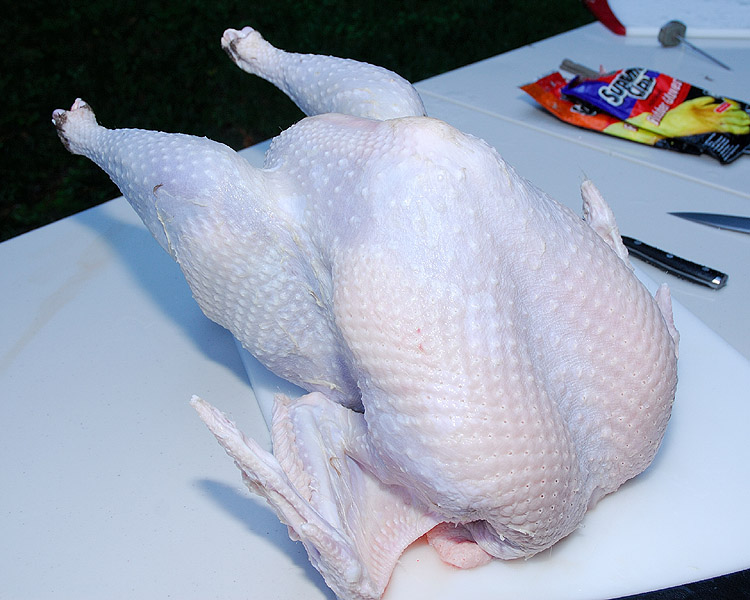
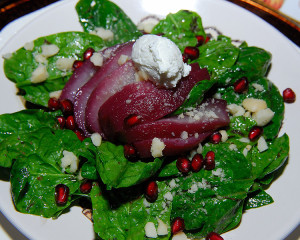

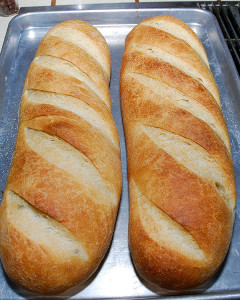
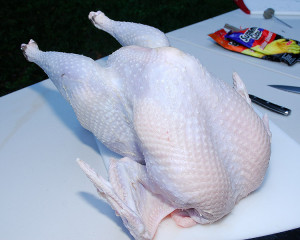


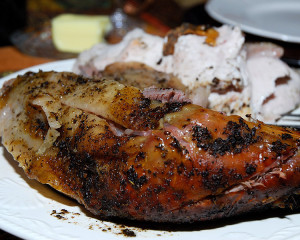




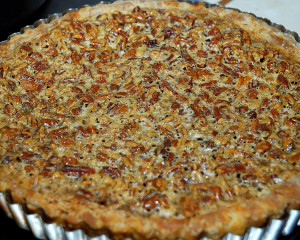







Your meal looked delicious. I am glad your bird was worth the effort and expense. I was surprised to read your review. I would not have guessed your bird to be so tender. I got a fresh bird this year (very juicy and tender) but it would undoubtedly not compare to your hand raised and well lived turkey.
We were very surprised how moist and tender this bird was. That’s why we went a little overboard with butter, barding, and broth…as insurance, but still the bird was far superior to any we’ve had before.
Hi CV,
Your meal looks wonderful, and no doubt you still have plenty of turkey left for sandwiches?
Ooooh, I’m feeling hungry now! Roll on Christmas when I can have some yummy roast meals too.
(I might just fit one in before though!)
Oh my, that looks like a feast fit for royalty! Cranberries three ways? And I thought WE were over the top! 😉
We’re saving our CSA heritage turkey for Christmas (it was frozen). I was amazed at the ‘long and lean’ look to it – definitely not broad-breasted. I will also be doing research as to how best to cook it. I must say your method looks delicious.
I’d love to hear how your heritage bird turns out at Christmas. I’m hoping we didn’t just have beginner’s luck! 😛
My-o-my, what a beautiful feast. And so, after the work at CVFarm mellows out, let’s hope you two create a restaurant…local of course!
Not sure I’d have the energy to be in the restaurant biz…how about a B&B? That’s more my speed 😛
okay so I’m drooling just a little bit over your dinner. Maple and balsamic mashed sweet potatoes! goodness me that sounds divine. Congratulations on raising such a wonderful bird and preparing such a lovely meal.
I actually should mention that I get no credit for the fabulous pecan tart, that was made by our guests, as were two of the cranberry compotes! 🙂
It all looks very delicious! You made me hungry and it is too bad we don’t have any leftovers. I bought a 20 pound turkey and thought we would have plenty leftover…ugh! My son wants me to cook another turkey just for sandwiches. I told him about lunchmeat. I guess it is just not the same, though. :)Enjoyed your post.
If only I had a cyber fork I would love to dine on this delicious post, dear Clare! A gal after my own heart, I so enjoy all that you share and continued thankfulness for our friendship 🙂
My goodness you have me drooling all the way up in Canada!! Looks like a wonderful feast, I’m glad you have a lovely Thanksgiving. 🙂
Hello Clare
Your thanksgiving feast sounds so mouthwatering especially when the main course was your own turkey and having pecan pie for dessert. I’ve no idea what maple whipped cream would taste like but I’m sure it’s sweet. Delia would be pleased – we make those roasters too.
As I type this we’re in the middle of winter here with a terrible blizzard and thunder and lightning all at the same time!
Dear Clare, This was indeed a banquet fit for royalty. I have no idea how you managed all those separate dishes, each of which sounded way beyond any of my capabilities. A very special Turkey this year and I was certain that it would taste delicious, which clearly it did.
Yowser! That was some Thanksgiving Feast. How wonderful to share such fare with your friends and family, and with those of us online.
Now about that pecan tart recipe, any chance of wrangling that from your friend and sharing?
Warm wishes – Tom (Boz & Gracie)
I had the same thought about wrangling the pecan tart recipe. I love this tart because it’s not too sickly sweet. Problem is she owns a local bakery…so the recipe is probably ‘top secret’ 🙁
Wow, I am hungry after reading your post even after all the food I have eaten this extended weekend. Do you provide recipes? I am especially interested in the pecan tart. My husband made a delicious pecan pie, but there’s always room for expansion. Carolyn
As it turned out, due to illness, we were unable to attend the Thanksgiving Day feast this year, for which we were responsible for the turkey and dressing. We sent them ready to pop in the oven, but alas, did not get a taste. (Sixty miles away and the folks coming back our way were not due for several days–too late for leftovers.
So I may just watch for an opportunity to buy a smaller, ranch-raised turkey (ours was truly free-range, fresh and supposedly almost as wholesome as yours) and give your recipe a try. Thanks so much for sharing your recipe.
Hi! I wanted to let you know that the blog carnival “How to Find Great Plants, Issue #1″ was published today and includes your post on garlic. Thanks for participating!
We were very happy with our local farm raised feast this season, but yours looks amazing right down to the cranberry sauce! Congratulations on your home-grown turkey!
Wow. I only have one thing to say .. YUM!!! I wish we had Thanksgiving here in Australia. Maybe I can try your dry curing turkey recipe for Christmas here instead, though I’m sure it wouldn’t be as nice with a store bought turkey. That has made me quite hungry.
Wow – that was a feast to write about! I’m glad your turkey was delicious; it sounds like it was worth the effort you put into raising, then perfectly preparing and cooking it. Congratulations!